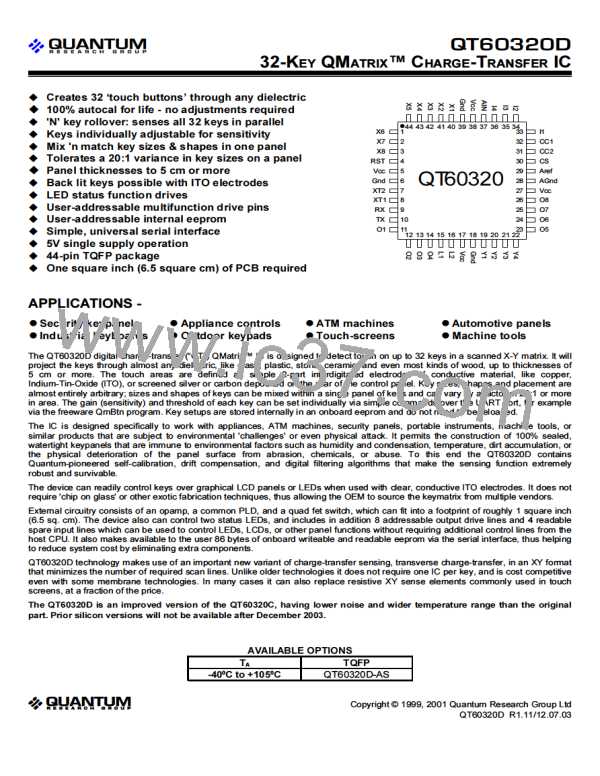since an approaching finger could be compensated for
partially or entirely before even touching the sense pad.
However, an obstruction over the sense pad, for which the
sensor has already made full allowance for, could suddenly
be removed leaving the sensor with an artificially suppressed
reference level and thus become insensitive to touch. In this
latter case, the sensor will compensate for the object's
removal by raising the reference level quickly.
Figure 1-6 Sample Electrode Geometries
1.6.3 THRESHOLD AND
H
YSTERESIS
C
ALCULATIONS
PARALLEL LINES
SERPENTINE
SPIRAL
The threshold value is established as an offset to the
reference level. As Cx and Cs drift, the reference drift
compensates with the changes and the threshold level is
automatically recomputed in real time so that it is never in
error. Since key touches result in negative signal swings, the
threshold is set below the signal reference level.
Y gate signals can be manipulated externally so that the gate
dwell time is very short to suppress the effects of surface
conductivity due to water films. See Section 2.3.
1.6 SIGNAL PROCESSING
The QT60320D employs a hysteresis of 25% of the delta
between the reference and threshold levels. The signal must
rise by 25% of the distance from threshold to reference
before the detection event drops out and the key registers as
untouched.
The QT60320D calibrates and processes all signals using a
number of algorithms pioneered by Quantum. These
algorithms are specifically designed to provide for high
survivability in the face of adverse environmental challenges.
1.6.1 SELF-CALIBRATION
1.6.4 MAX
ON-DURATION
The QT60320D is fully self-calibrating. On powerup the IC
scans the matrix key by key and sets appropriate calibration
points for each in accordance with setup information in its
internal eeprom, or on the fly from a host MPU. Since the
circuit can tolerate a very wide dynamic range, it is capable of
adapting to a wide mix of key sizes and shapes having wildly
varying Cx coupling capacitances. No special operator or
factory calibration or circuit tweak is required to bring keys
into operation, except for a gain and threshold batch setup
which can be performed in seconds from a file saved on a
PC. Once set, there should never be a need to readjust these
parameters.
If a foreign object contacts a key the signal may change
enough to create a 'false' detection lasting for the duration of
the contact. To overcome this, the IC includes a timer which
monitors detection duration. If a detection exceeds the timer
setting, the timer causes the sensor to perform a full
recalibration. This is known as the Max On-Duration feature.
After the Max On-Duration interval has expired and the
recalibration has taken place, the affected key will once again
function normally even if still contacted by the foreign object,
to the best of its ability. The Max On-Duration is fixed at 10
seconds of continuous detection.
1.6.2 DRIFT
C
OMPENSATION
A
LGORITHM
1.6.5 DETECTION
I
NTEGRATOR
Signal drift can occur because of changes in Cx and Cs over
time. It is crucial that drift be compensated for, otherwise
false detections, non-detections, and sensitivity shifts will
follow.
To suppress false detections caused by spurious events like
electrical noise, the QT60320D incorporates a detection
integration counter that increments with each detection
sample until a limit is reached, at which point a detection is
confirmed. If no detection is sensed on any of the samples
prior to the final count, the counter is reset immediately to
zero, forcing the process to restart. The required count is 4.
Drift compensation (Figure 1-7) is performed by making the
reference level track the raw signal at a slow rate, but only
while there is no detection in effect. The rate of adjustment
must be performed slowly, otherwise legitimate detections
could be ignored. The QT60320D drift compensates using a
slew-rate limited change to the reference level; the threshold
and hysteresis values are slaved to this reference.
When a finger is sensed, the signal falls since the human
body acts to absorb charge from the cross-coupling between
X and Y lines. An isolated, untouched foreign object (a coin,
or a water film) will cause the signal to rise
slightly due to the enhanced coupling thus
created. These effects are contrary to the way
most capacitive sensors operate.
Figure 1-7 Drift Compensation
Once a finger is sensed, the drift compensation
mechanism ceases since the signal is
legitimately low, and therefore should not cause
Reference
Hysteresis
Threshold
the reference level to change.
The QT60320's drift
compensation
is
'asymmetric': the drift-compensation occurs in
one direction faster than it does in the other.
Specifically, it compensates faster for increasing
signals than for decreasing signals. Decreasing
signals should not be compensated for quickly,
Signal
Output
LQ
4
QT60320D R1.11/12.07.03

 QUANTUM [ QUANTUM RESEARCH GROUP ]
QUANTUM [ QUANTUM RESEARCH GROUP ]